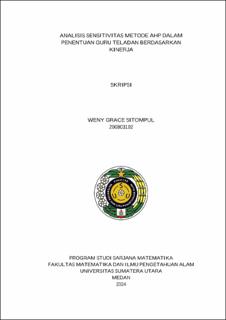| dc.description.abstract | The aim of this research is to examine the final ranking results of the AHP method through sensitivity analysis. The sensitivity value is sought because of the problem of changing the weight of the decision criteria. This sensitivity analysis can be used to predict the situation if the current criteria or sub-criteria parameters change without changing the total weight. A case example in this research is the determination of an exemplary teacher at SDN 028068 Binjai based on their performance using the AHP method. This research uses six criteria, namely Academic Qualifications (K1), Educator Certificate (K2), Pedagogical Competency (K3), Personality Competency (K4), Social Competency (K5), and Professional Competency (K6), By using the AHP method, initial ranking results can be obtained. From the final results of the initial ranking using the AHP method, experiments were carried out through several stages of sensitivity analysis to predict the situation when the criteria weight values changed. Through the results of sensitivity testing carried out on these six criteria, various results were obtained. K2+0,1 generally experienced the most changes in priority order, especially K2+0,1 ;K1−0,1 (change when the criteria weight value is added by 0.1 while criterion 1 is reduced by 0.1) namely with 12 changes in the order of alternative priorities. Then through the sensitivity testing process K5+0,1;K6−0,1 has the highest sensitivity value 1, namely with a value of 0.0282,K5+0,1;K1−),1 has the highest sensitivity value 2, namely with a value of 0,1269, and K6+0,1; K5−0,1 has the third highest sensitivity value, namely 0,1256. From the results of this experiment, it can be seen that the greater the change value, the more the number of alternative priority orders changes. Many changes in the priority order of alternatives are also influenced by variations in alternative scores based on the data obtained for each criterion. | en_US |


